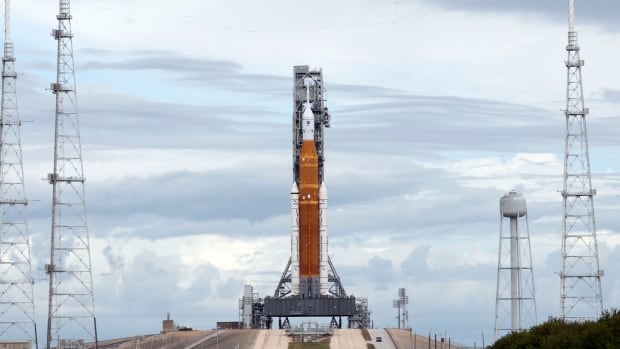Here we go again.
After two scrubbed launch attempts and two hurricanes that pounded the Space Coast, NASA is once again trying to get its giant moon rocket off the ground.
Artemis I, the first mission in NASA’s Artemis program that will return astronauts to the moon, is scheduled to liftoff on Wednesday at 1:04 a.m. ET, with a two-hour launch window.
You can watch the launch here beginning at 12:30 a.m.
The Space Launch System is the space agency’s most powerful rocket ever built. Atop it sits the Orion spacecraft, which will one day ferry astronauts to and from the moon. The last time humans were on the moon was in December 1972.
This is an uncrewed mission, with the only passengers being three mannequins on board that are part of a few experiments, including testing a vest that will protect astronauts from lethal space radiation.
Artemis II, set to launch in 2024, will carry four astronauts — including a Canadian — who will orbit the moon and return to Earth.
Artemis III, set to launch in 2025, will see humans once again on the surface of the moon.
But trying to get the Artemis mission up and going has been quite the challenge for NASA.
Originally, the rocket was supposed to launch on Aug. 29. However, the space agency encountered several issues that day, including a delay in loading the rocket’s propellant due to stormy weather. Then the two types of propellants — liquid oxygen and liquid hydrogen — weren’t loading at acceptable rates. Finally, one of the four rocket engines failed to cool down as expected, and eventually crews ran out of time in the launch window and were forced to scrub the launch.
A second launch attempt on Sept. 3 was also scrubbed due to fuel loading issues and a hydrogen leak.
Then came the hurricanes.
First, it was Hurricane Ian that forced NASA to roll the rocket back to the Vehicle Assembly Building. The hurricane made landfall from the Gulf of Mexico on Sept. 28 as a Category 4 storm and, though it did not cause extensive damage at the Kennedy Space Center, the space agency wanted to inspect the pad and allow its workers time to take care of themselves, which further delayed the launch.
Then there was Hurricane Nicole, which made landfall on Nov. 10 just south of the Kennedy Space Center as a Category 1 storm. NASA had rolled the rocket back to the launch pad on Nov. 4 for a launch on Nov. 14. Once Nicole had developed, however, it was too late to roll the 32-storey rocket back to the safety of the assembly building, so the rocket remained on the pad during the storm, and the launch date was moved to Nov. 16.
The rocket did experience some issues from being left in the storm.
One was some tearing of some thin caulking that surrounds Orion, which essentially fills in the gaps in the thicker insulation and prevents any air circulation or heating. There was concern that if more of it were to break off during launch, it could damage the rocket, potentially catastrophically.
Another concern was the tail service mast umbilical. This 10-metre tall structure lies near the bottom of the rocket and consists of several lines that feed propellant and electricity to the core stage of the rocket. Engineers were receiving “inconsistent” data, even though they had replaced one of the connectors earlier.

Despite these issues, in a media teleconference on Monday evening, mission managers said they were confident that they could still fly.
“There’s no change in our plan to launch on the 16th,” said Artemis mission manager Mike Sarafin. “In terms of the two issues that we reviewed … I would say we’re comfortable flying as is.”
The reasoning is that, for the mast umbilical, there are redundant systems in place. As for the caulking, they reviewed it and believe that no more would break off, and even if it did, there would be a low chance it would be a catastrophic risk to the rocket.
Sarafin noted that the same caulking was used in flight for the original test flight of the Orion spacecraft, and they did not see any issues of it detaching.
When it comes to the possibility of yet another leak during the propellant load, Jeremy Parsons, exploration ground systems program deputy manager at the Kennedy Space Center, said they aren’t concerned they will encounter the previous issues.
“We are more confident than we’ve ever been in our loading procedures,” he said.
The hours-long tanking will begin at 3:30 p.m. ET Tuesday.
If the rocket launches Wednesday, Orion will have a 26-day mission to test multiple systems, including most importantly, a new heat shield that is designed to protect astronauts from heat as they re-enter the atmosphere at nearly 40,000 km/h.

Overall, the feeling is positive at the space agency that they are ready to overcome any other challenges that may develop along the way. Parsons noted that the entire team has persevered through a lot trying to get Artemis to launch.
Sarafin agreed.
“Our time is coming, and we hope that is on Wednesday,” Sarafin said. “But if Wednesday is not the right day, we will take that next hurdle, that next trial and persevere through that.”


